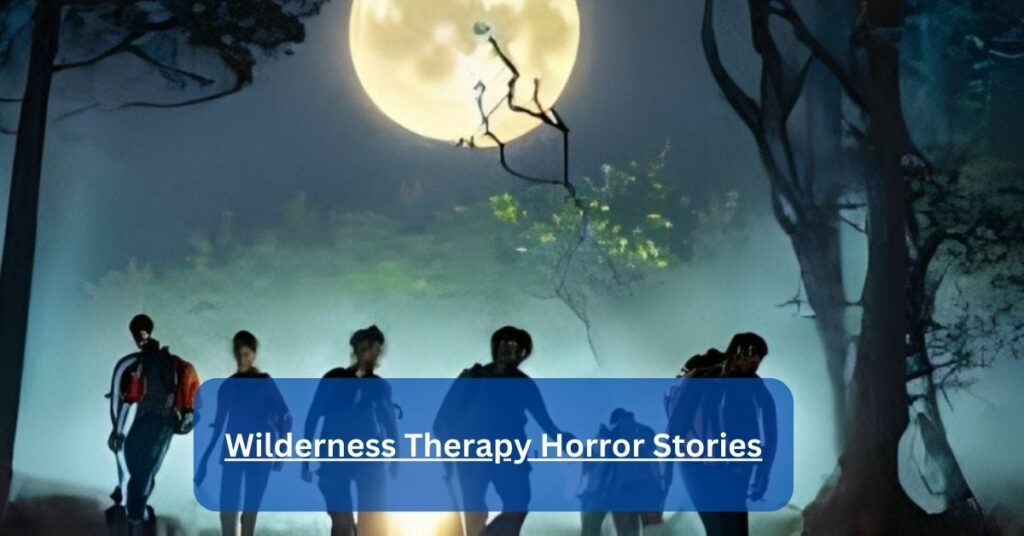Wilderness Therapy Horror Stories – Understanding The Risks And Realities!

Wilderness therapy, which some people praise for its ability to help change lives, also has its problems. While many people feel better and learn a lot in nature, others have really tough experiences that stay with them for a long time.
Wilderness therapy, which is also called outdoor behavioral healthcare, means doing therapy in nature. It can help some people, but sometimes it can lead to bad experiences or results.
In this article, we’re going to look at the not-so-good parts of wilderness therapy. We’ll talk about real stories that weren’t so great and talk about the dangers and truths about these programs.
Understanding Wilderness Therapy:
Wilderness therapy is when people get therapy in places like forests, mountains, deserts, and rivers. People who are dealing with problems like feeling sad, using drugs too much or acting out go on trips with trained helpers. Being in nature is thought to help people think about themselves, become stronger, and become better people by doing activities outside and being part of a group.
Real-Life Horror Stories – Explore The Dark Side Of Wilderness Therapy!
1. Abuse and Neglect:
Many people have talked about bad things happening in wilderness therapy programs. They say that staff or other people there have hurt them physically said mean things to them, and made them feel bad on purpose. Sometimes, the people in charge let this happen without doing anything about it.
2. Tragic Endings:
There have been very sad times when people have died while they were at wilderness therapy camps. This could happen because of accidents, when someone gets really sick, or if the people in charge don’t react quickly enough when something goes wrong. Families who lose someone they love in these situations often wonder if the camps have enough rules to keep everyone safe and if they’re being watched over properly.
3. Isolation and Desperation:
Being alone in wilderness therapy can make some people feel even more sad and hopeless. They might not have their usual friends or people to talk to, and there aren’t many mental health services available. This can make it really hard for them, especially when dealing with tough situations in the wild or with other people in the group.
4. Legal Battles and Accountability:
The law has investigated some wilderness therapy programs for their actions. Families of people who were hurt or had a bad experience during these programs have taken legal action against the people running the programs. They want fairness and compensation for the harm caused.
5. Psychological Trauma:
Participants who already have mental health issues or have experienced trauma before might feel even worse because of wilderness therapy. The program’s tough activities and lack of enough help for mental health could make their symptoms worse and cause lasting emotional problems.
Revealing The Dark Realities Of Wilderness Therapy – A Look Into Troubled-Teen Camps!
One morning in 2007, when Sarah Stusek was 17 years old, she woke up suddenly because bright lights were on, and strangers were standing near her bed. Without telling her why, she was taken from her home in Annapolis, Maryland, to a wilderness therapy camp called Three Rivers in Montana. This surprise move, which felt like a kidnapping, was actually allowed by the law, showing that troubled teen camps in the United States aren’t well-regulated.
Challenges And Controversies In Wilderness Therapy Programs – Dive Deeper Into The Chilling Tales!
Rowan Bissette was only 16 years old when she was taken from Florida to Utah against her wishes by two strangers. She had never left her home state before.
Her parents hired these men to move her from a psychiatric hospital in Jacksonville to a residential facility in Utah for more intense care. Rowan was scared. Despite having therapy twice a week for five years, Rowan was still struggling with self-harm and suicide attempts. Her parents hoped this new facility would finally help her.
Rowan was flown to Sunrise Residential Treatment Center in Utah, where she became violent and was often restrained. After getting kicked out, she was sent to a hospital, only to be told the night before she was discharged that she was going to a wilderness therapy program in WinGate, Utah.
At WinGate, Rowan faced harsh conditions, including long hikes in the desert heat with heavy backpacks and limited food. She experienced mistreatment from staff, including inappropriate behavior and threats. After leaving WinGate, Rowan attended multiple treatment centers, facing challenges and mistreatment along the way. Despite her struggles, she now lives a full life but still deals with PTSD from her traumatic experiences.
Wilderness therapy programs like the one Rowan attended claim to help troubled teens through nature immersion. However, many of these programs lack proper oversight and can lead to further harm. While some individuals have had positive experiences with wilderness therapy, others have faced abuse and trauma. The industry remains largely unregulated, with parents often unaware of the risks associated with sending their children to these programs.
Navigating The Risks – Learn How To Protect Yourself Or Your Loved Ones From Potential Dangers!
While wilderness therapy horror stories are unsettling, it’s essential to approach these programs with caution rather than outright dismissal. Here are some tips for navigating the risks associated with wilderness therapy:
Research Thoroughly: Look up information about wilderness therapy programs to see if they’re safe and have qualified staff. Check if they have official approval, a good history of safety, and staff who are trained properly. Read what people who have been in the program before say about their experience to get an idea if it’s good or not.
Ask Questions: Don’t hesitate to ask detailed questions about safety protocols, emergency procedures, staff-to-participant ratios, and the program’s approach to addressing mental health needs. Transparent communication is key to ensuring peace of mind.
Consult Professionals: Seek guidance from mental health professionals, counselors, or trusted advisors before committing to a wilderness therapy program. They can offer insights tailored to your specific needs and circumstances, helping you make an informed decision.
Stay Vigilant: Keep watching carefully during the program, and if you see anything that seems like someone is being treated badly or ignored, or if there are any dangers, speak up. Trust what you feel and stand up for yourself or your family member if you’re worried about something.
Frequently Asked Questions:
1. Are all wilderness therapy programs unsafe?
Not necessarily. While there have been instances of abuse and neglect in some programs, many reputable wilderness therapy providers prioritize participant safety and well-being through rigorous safety protocols and professional standards.
2. How can I tell if a wilderness therapy program is reputable?
Look for programs that recognized organizations accredit, have transparent safety records, employ qualified staff with relevant certifications, and prioritize participant feedback and well-being.
3. What should I do if I encounter issues during a wilderness therapy program?
Trust your instincts and communicate any concerns with program staff or administrators immediately. If the issues persist or escalate, consider removing yourself or your loved one from the program and seeking support from mental health professionals or authorities.
Conclusion:
Wilderness therapy can be both helpful and risky. Some people feel better and learn much in the wilderness, but others have tough times. Knowing about the problems and doing things to make them safer is essential.
Families should think carefully before choosing wilderness therapy. They should make sure it’s safe, fair, and follows good rules to make sure everyone has a good experience. Safety, fairness, and sound rules are crucial to making certain wilderness therapy helps people in a good way.






